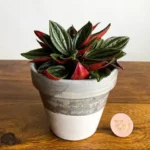Introduction
If you’re searching for a visually striking houseplant that brings an exotic jungle feel to your indoor space, Anthurium clarinervium may be the perfect choice. Known for its velvety, dark green leaves and bold, white venation, this plant has taken the plant-loving world by storm. But don’t let its tropical looks intimidate you — with the proper care and clear guidance, even beginner gardeners can successfully grow this compact beauty.
In this comprehensive guide, we’ll explore everything you need to know about growing Anthurium clarinervium indoors, including ideal lighting levels in lux, watering practices tied to climate and container size, temperature and humidity needs, common care issues, and more.
Meet Anthurium clarinervium
Botanical Background
Botanical name: Anthurium clarinervium
Family: Araceae
Native range: Limestone grottos and tropical forests of Chiapas, southern Mexico
Discovery and cultivation: First described in the mid-20th century, A. clarinervium is a true wild species, not a hybrid. It has become a staple in ornamental horticulture due to its dramatic foliage and manageable size.
Foliage Appeal
The heart-shaped leaves are thick and velvety, with an almost suede-like texture. The white to silvery venation contrasts strikingly against the deep green foliage, making this plant a favorite for collectors and interior decorators.
Lighting Requirements in Lux
Understanding light in measurable terms is essential for successful care. Anthurium clarinervium naturally grows in filtered light under forest canopies, making it a low-to-medium light plant. Here’s how to translate that into indoor conditions:
- Optimal range: 8,000–15,000 lux – Bright, indirect light; near an east or north-facing window, or a filtered south window.
- Acceptable range: 5,000–8,000 lux – Lower light levels are tolerated, but growth may slow.
- Minimum for survival: 2,000 lux – The plant may survive for a time but will lose vibrancy and become leggy.
- Too bright: 20,000 lux and above – Direct mid-day sunlight will scorch the velvety leaves.
Can You Use Grow Lights?
Yes, full-spectrum LED grow lights rated at 2,000–3,000 lumens (roughly 8,000–12,000 lux at 12 inches) can effectively supplement natural light. Use a timer to mimic a 12-hour day/night cycle. Ideal for winter months or dim spaces.
Watering Schedule: Based on Season, Pot Size & Humidity
General Guidelines
Anthurium clarinervium prefers moderate moisture — not wet, not dry. Overwatering and root rot are common beginner mistakes.
- Spring/Summer (active growth): Water every 5–7 days if humidity is below 50%, or every 7–10 days in higher humidity.
- Fall/Winter (dormant period): Water every 10–14 days or as the top 2 inches feel dry.
Pot Size & Material Impact
- Small pots (4–6”): Dry out more quickly; monitor soil every 4–5 days in warm months.
- Large pots (8”+): Retain moisture longer; water less frequently, and check deeper layers before watering.
- Terracotta pots: Allow faster evaporation – ideal for avoiding overwatering.
- Plastic or glazed ceramic pots: Retain more moisture – water with extra caution.
Humidity Influence
If your indoor air is above 60% humidity, extend the time between waterings as moisture evaporates more slowly. A hygrometer is an easy tool to help adjust watering accordingly.
Ideal Temperature & Humidity Ranges
Temperature
- Optimal range: 18°C–24°C (65°F–75°F)
- Minimum survival: 12°C (54°F); prolonged exposure causes leaf drop and root damage
- Maximum tolerated: 30°C (86°F), provided humidity remains high
Humidity
- Ideal relative humidity: 60%–80%
- Tolerable minimum: 45%; leaf edges may crisp below this level
- Too low: < 40% may cause persistent browning and stunt growth
Tip: Place your plant in a bathroom with indirect lighting, or use a pebble tray and humidifier to raise local humidity.
Common Problems and Their Solutions
Yellow Leaves
Cause: Overwatering or poor drainage
Solution: Check root health; reduce watering frequency; switch to well-draining mix with perlite and orchid bark.
Brown Leaf Edges
Cause: Low humidity or salt buildup
Solution: Increase humidity and flush soil monthly with distilled water.
Leggy Growth
Cause: Insufficient light (below 4,000 lux)
Solution: Move the plant closer to a light source or add supplemental grow lighting.
Pests (e.g., spider mites, mealybugs)
- Identify: Webbing under leaves or white cotton-like masses
- Treat: Wipe with 70% isopropyl alcohol or apply neem oil weekly until pest-free
Is Anthurium clarinervium Toxic?
Yes. Like most aroids in the Araceae family, A. clarinervium contains insoluble calcium oxalate crystals that can irritate the mouth and digestive tract if ingested.
- Humans: Toxic if chewed or swallowed. Keep away from young children.
- Pets (cats/dogs): Known to cause drooling, oral pain, vomiting (ASPCA, 2024)
Always wear gloves when pruning or repotting, especially if you have sensitive skin.
Useful Tricks for Successful Care
- Water with filtered or rainwater: Tap water high in minerals may cause leaf tip burn over time.
- Turn the plant monthly: This promotes even, symmetrical growth in low light conditions.
- Repot every 2–3 years: Use a chunky mix of sphagnum moss, perlite, charcoal, and coco coir for aeration.
- Prune yellowing leaves: Clean scissors with alcohol before and after cutting to prevent fungal spread.
- Fertilize sparingly: Feed with a diluted (1/4 strength) balanced fertilizer every 4–6 weeks in spring/summer only.
Conclusion
Anthurium clarinervium offers unmatched visual appeal for indoor gardeners who enjoy dramatic foliage. While its care may seem specific, the rules are straightforward once you understand the plant’s tropical origins and native environment. Pay close attention to light (8,000–15,000 lux), maintain moderate watering schedules based on your environment, and ensure adequate humidity and warmth year-round. With patience and consistency, this plant will reward you with vibrant leaves that continue to delight season after season.
Whether you’re a novice houseplant keeper or an expanding enthusiast, Anthurium clarinervium is a gratifying species to grow and master. Don’t forget to monitor conditions, observe your plant’s responses, and adapt based on real-world feedback. That’s the secret to healthy indoor gardening!
References
- American Society for the Prevention of Cruelty to Animals (ASPCA). (2024). Toxic and Non-Toxic Plants: Anthurium. Retrieved from https://www.aspca.org/pet-care/animal-poison-control/toxic-and-non-toxic-plants/anthurium
- Bown, D. (2000). Aroids: Plants of the Arum Family. Timber Press.
- Exell, A. W. (1987). Flora Neotropica Monograph 14: Anthurium. New York Botanical Garden Press.








